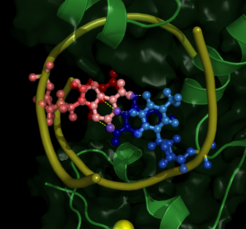Specific DNA Binding and Recognition: Predicting the Binding Affinity of the Transcription Factor ZIF268

The binding affinity of DNA-binding proteins, e.g. transcription factors, such as ZIF268 (also: EGR1, Krox24, NGFI-A), is essential for the function of these proteins. It is one fundamental goal in modern biochemistry to find out, why, and more importantly, how these proteins bind selectively to specific DNA sequences. For some proteins, the exchange of one single basepair yields a large loss in binding affinity [Berg et al., 1986]. This lead to the assumption that the interaction between single aminoacids involved in binding and the bases is very specific. However, interactions with the DNA backbone and the second strand must not be excluded.
A very important class of DNA-binding proteins are transcription factors. Their binding induces transcription of DNA and thus the expression of specific proteins. Usually those transcription factors contain from one to multiple zinc finger (ZF) motifs, which consist out of a ββα-structure, complexing a zinc ion [Wright et al., 2001] (Figure 1).
Besides the well known complexity of binding, each motif roughly binds to one base-triplet [Pabo et al., 2001]. Creating proteins from several ZF-motifs artificially, therefore yields powerful tools to express specific proteins in a cell, or to bind selectively to DNA-strands in in vitro-assays [Pabo et al., 1999].

The goal of our work is to predict relative binding affinities for protein-DNA-complexes from free energies, calculated by Molecular Dynamics simulations with Free Energy Perturbation (FEP) [Kollmann et al., 1989] and slow-growth Thermodynamic Integration (TI) [Kirkwood, 1935] methods, carried out with the GROMACS package [Berendsen et al., 2005]. Figure 2 shows the two states for the TI calculation (from A-state to B-state via a coupling-parameter λ over time).

